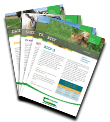
Dairy Newsletter – July 2025
In this month’s issue: July top five tips Are your milk liners due a change? Milking machine liners should be changed every six months or after 2,000 milkings (whichever comes first). Complete a winter fodder budget: there is plenty of silage on most farms, but many first cuts were lighter than normal this year. Keep […]
07 July 2025
Type Newsletter
By Teagasc Dairy Specialist team
Download Publication (PDF)
In this month’s issue:
- July top five tips
- Are your milk liners due a change? Milking machine liners should be changed every six months or after 2,000 milkings (whichever comes first).
- Complete a winter fodder budget: there is plenty of silage on most farms, but many first cuts were lighter than normal this year.
- Keep focused on grass: continue to walk the farm regularly to assess grass availability and quality.
- End the breeding season: cows bred in July will not be calving until mid to late April next year.
- Think safety: July is one of the most dangerous months of the year on farm. Make safety a priority, with special attention to child safety during the school holiday period.
- Tidy up sward quality
Grass growth in June was variable on many farms, leading to some heavy covers being grazed over the last few weeks. This has resulted in some high post-grazing residuals and poor grass quality in paddocks. July is the month to fix any issues with sward quality before we start building grass supply in August. - Potash needs to be returned after bales
The capability of grass to grow starts below the surface. If the major elements of phosphorus (P) and potassium (K) are compromised, less grass will be grown. A lot of soils are Index 1 or 2 for K and therefore deficient. This is particularly true of silage ground; however, it is now becoming more common on the grazing area. - Plan for long-term return on investment
With money hard earned and never guaranteed on dairy farms, give careful consideration before re-investing profits. There are always more ways to spend money than there is money available, and every option has its pros and cons. - Taking stock of winter feed
It has been a decent year for forage. Silage season was completed earlier than usual and second cuts have had a good period of growth. Taking first cuts in May should ensure that second cuts can be completed by mid to late July. It is a great chance to build some silage reserves. The target is to have a rolling surplus of 400-600kg DM per cow (two to three bales) on hand above normal requirements. - Health & Safety – Children farm safety webinar
With children home from school, they are particularly vulnerable to dangers on the farm, like vehicles, livestock, and slurry pits. Children must be supervised at all times when they are on a farm. Teagasc recently produced an informative farm safety webinar for children, ‘Stay safe with Jessy’, which featured Agrikids. Jessy is the Teagasc farm safety mascot. Take time to show this to the young people in your life. Watch the webinar back here
